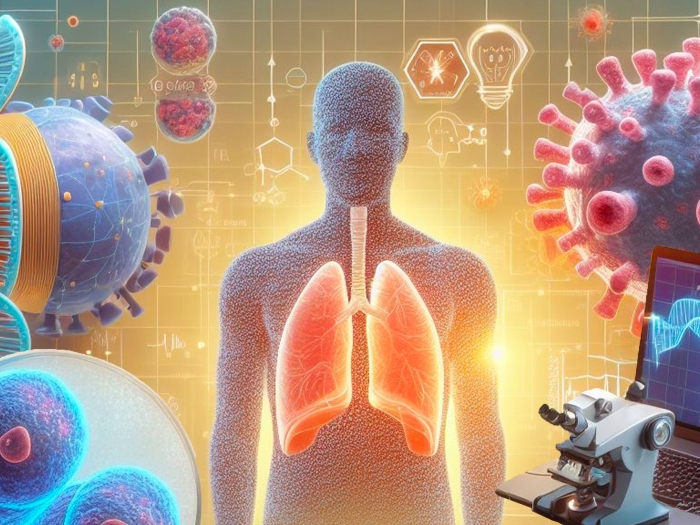A missing protein led an otherwise healthy father to the operating room for a life-saving transplant.
12:00 PM
Author |

For nearly 20 years, Paul DeWyse fought a losing battle against an alpha-1 antitryspin deficiency, a hereditary disease which caused his lungs to slowly die.
At age 55, the Livonia, Michigan resident escalated his fight against his illness with the boldest treatment medicine can offer: a double lung transplant at the University of Michigan Transplant Center.
The procedure and its aftermath posed the greatest challenge of his life. But now, 19 months later, DeWyse, a lifelong athlete, is able to enjoy the benefits of having two healthy lungs again. This past summer he walked, played golf, rode his bike and had more energy to spend with his wife, Marci, and their three daughters, all without being tethered to an oxygen tank that had constricted his world, and his hope.
"I was down to about 15% lung capacity," he says. "I could barely walk 15 feet without having to take a rest. It was bad."
Hearing the diagnosis
Paul's life changed in fall 1998, when a bout with pneumonia sent him to the emergency room.
"I was 37 when I found out I had this fatal disease," he says. DeWyse then discovered he only had five years to live.
Alpha-1 antitryspin deficiency is a rare disease, impacting about 1 in 1,500 to 3,500 individuals worldwide with European ancestry, according to the National Institutes of Health. It's a condition in which the body doesn't make enough alpha-1 antitryspin (AAT), a protein that protects the lungs and liver from damage. A deficiency means the gene that makes AAT isn't producing enough of the protein which protects the body from an enzyme called neutrophil elastase. When neutrophil elastase enzyme is released from white blood cells to fight infection, it attacks normal tissue in the absence of AAT, especially in the lungs, which are tiny air sacs within the lungs that allow oxygen and carbon dioxide to move between the lungs and the bloodstream. This can cause lung disease, and may also cause damage to the liver.
The onset of symptoms for people with an alpha-1 antitryspin deficiency typically emerges in adults between the ages 20 to 50. Symptoms include shortness of breath, wheezing and an increased risk of lung infections. Paul DeWyse experienced these symptoms, along with emphysema, and his lung capacity at diagnosis was at 45%. Others living with this condition have COPD, cirrhosis, panniculitis, a skin condition in which bumps appear below the skin, or vasculitis, which is an inflammation of the blood vessels.
Even though DeWyse inherited this incurable condition from his parents who are both carriers of the mutation, none of his family members, including his siblings and children, have the illness.
LISTEN UP: Add the new Michigan Medicine News Break to your Alexa-enabled device, or subscribe to our daily updates on iTunes, Google Play and Stitcher.
Treating the disease
DeWyse wasn't going down without a fight. To slow the progression of his lung breakdown, Paul's wife Marci DeWyse, who had studied nursing, gave her husband an IV of Prolastin every week to introduce AAT back into his bloodstream. She did that every week for 18 years, which required more than 930 needle pokes to the skin.
"I was very close to getting a port put in, but I feared infection," he says.
DeWyse, who's a sales manager at Alloya Corporate Federal Credit Union, kept up his rigorous workout schedule to stay in shape, often playing racquetball. Even when he was down to 15% lung capacity and on the transplant list in September 2017, he hit the gym.
"It would take me a lot longer because when I went to the gym, I could only walk so far and needed to sit down and rest for five minutes before I could continue," he says. "But I'm stubborn."
MORE FROM MICHIGAN: Sign up for our weekly newsletter
He hid the illness for as long as he could from his clients, often leaving his oxygen tank in the car before meetings, but living with his condition continued to get increasingly difficult as his lungs progressively deteriorated, he said. He needed oxygen 24 hours a day, and without a transplant, he would die.
He soon met pulmonologist Kevin Chan, M.D., the medical director of lung transplantation at Michigan Medicine, and the rest of Michigan Medicine's transplant team, who immediately put him at ease.
"He is a young, strong healthy guy with a positive attitude," Chan says, which are ideal qualities in a patient. "It's important to be physically fit before the transplant because the recovery will be stronger."
Getting the call
The DeWyse family had just sat down for dinner on Christmas Day 2017, when Michigan Medicine called with the news: They had a set of lungs for Paul.

After arriving at the hospital and enduring roughly 18 hours of prep, Paul was ready to enter the operating room when he received devastating news. Medical staff had spotted pneumonia on an X-ray of the lungs, making them unusable.
"I was depressed, I admit, because it was rough hearing that," he says.
But Paul received another call in February 2018 while at a work conference in Detroit; one that would change his life.
The procedure lasted just under six hours, potentially a record time for the transplant team that performed his operation. He remained hospitalized for two weeks, but was up and walking within three days after his transplant.
Life after transplant
"By May, I was feeling better and ready to golf," he says.
DeWyse says the summer of 2019 was the best summer he'd had in a long time.

It was a warm, sunny season filled with deep breaths, lots of physical activity, endless energy and time spent sharing his transplant story with multiple groups around the state, including his employer, Alloya, who supported him during his recovery, and made a donation in his honor to the Transplant Center.
"I am seriously just so happy to be alive and have a second chance at life," he says.

Explore a variety of healthcare news & stories by visiting the Health Lab home page for more articles.

Department of Communication at Michigan Medicine
Want top health & research news weekly? Sign up for Health Lab’s newsletters today!





